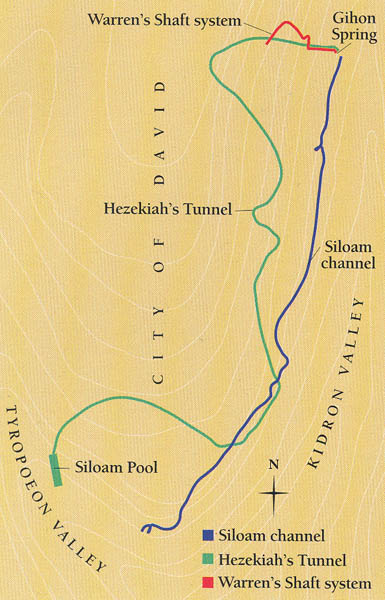Three water systems have tapped the Gihon Spring at various times in history (shown here). The oldest of these, shown in red, is known as Warren’s Shaft after its modern discoverer, Captain Charles Warren; it consists of a vertical shaft and tunnels that gave the people within the city protected access to the water of the spring, which lay outside the city wall. Because the Gihon Spring lies low on the slope, the Jebusites (and the Israelites later) could not include it within their city wall without exposing the wall’s defenders to possible attack from anyone on the slope across the Kidron Valley.
The next water system to be built was the Siloam channel, shown in blue. It served as an aqueduct that irrigated the adjacent fields through openings in the channel wall. Its position outside the city wall indicates that it was used during a peaceful period, so archaeologists suggest that it may date to Solomon’s time.
Excerpted from Philip J. King, “Bible Lands- Exploring the valleys of Jerusalem,” BR 7-02, Apr 1991.
See also:
- Public Building in the City of David, 10th century BCE
- Warren’s Shaft, 8th century BCE
- Hezekiah’s (or Siloam) Tunnel Inscription, 701 BCE
- Pool of Hezekiah
- Pool of Siloam
- The Village of Siloam
- Queries and Comments- Who Chiseled Out the Siloam Inscription? BAR 10-05, Sep-Oct 1984.
- How Water Tunnels Worked, Dan P. Cole, BAR 6-02, Mar-Apr 1980.
- Jerusalem’s Water Supply During Siege, Yigal Shiloh, BAR 7-04, Jul-Aug 1981.
- The City of David After Five Years of Digging, Hershel Shanks, BAR 11-06, Nov-Dec 1985.
- City of David Videos

